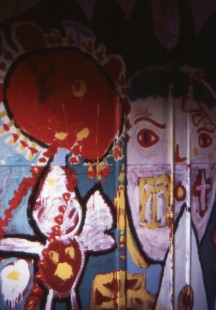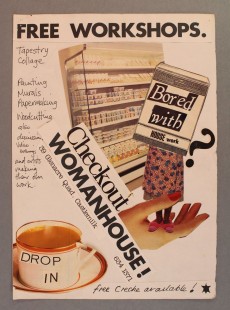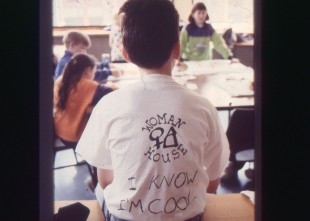CUTTING A LONG STORY SHORT

Women in Profile ‘Womanhouse’ project began as an idea for a collaborative artwork which would, by its context, address historical and contemporary notions of women’s creativity, within and outside the home. Women artists from all over Britain worked alongside women and children from Castlemilk in Glasgow; during the summer of 1990 four flats in an empty tenement block became a huge living(room)artwork and a meeting place for women and children in the neighbourhood.
In embarking on the project and to give it some visible reference we looked initially to Judy Chicago and Miriam Shapiro’s ‘Womanhouse’ (Los Angeles, 1971) with the intention of reclaiming and reassessing some of the ideas with which it dealt. The project continued to develop through analysis of feminist art practices and related issues such as self-representation, authorship and specialisation; and, in practical terms, realising the need for those resources that allow for self-determination and empowerment within a wider context.
That the project would provide the initiative for the development of a permanent resource for women was of fundamental importance from a very early stage. Whilst appreciating the profile (not to mention funding) that the ‘City of Culture’ accolade would provide for 1990 arts initiatives, members of the group were concerned that any funding directed into this particular project would, as far as possible, facilitate some form of ongoing provision. This seemed all the more important if the project was to be sited in a non-central location.

Castlemilk is a large housing estate on the outskirts of Glasgow built during the slum clearances in the 1950s. While there are many vital and broad-based initiatives already in existence covering some parts of the scheme (a good few are vocational to a large extent) there is still a severe lack of facilities, high unemployment and many areas remain depressed and isolated. The project was ultimately located here for a number of reasons. Castlemilk is designated an ‘Area for Priority Treatment’ and a ‘10 Year Regeneration Plan’ was recently embarked upon. The likelihood of gaining more permanent funding in view of this, combined with the availability of empty properties (despite the acute housing shortage in Scotland as a whole) and the encouragement of the newly formed Castlemilk Fringe organisation (which this year appointed an Arts/Cultural Development Officer) made the area a pertinent choice and gave us the opportunity to direct some of the Cultural City monies away from the ‘cultural hotspots’ and tourist centres.
During the two year period of research, planning, fundraising and diplomacy our aims for the project shifted through a series of progressions, though we remained committed to most of our fundamental plans; this, despite a range of considerable financial and bureaucratic hurdles, and we finally gained access to the building in June 1990. It was at this point, with the project at least three months behind schedule, that the work really started.
Adverts had been placed with various national and local arts press and organisations in the spring and applicants had furnished us with descriptions and illustrations relating to their intended work. The successful applications were selected at the earliest stages of occupancy by local women (already helping with preparation within the building) along with the co-ordinators. As the creative partnership amongst women and children working together evolved over the ensuing weeks the project continued to try and gear itself towards the specific needs of women (particularly where childcare provision was concerned). Locating the project in a house gave women and children from different backgrounds the opportunity to create a form of shared confidence in themselves by making and exhibiting work in a place traditionally designated as theirs, transformed by their own efforts from its historically private to a dauntingly public space; and beyond the notion of a patriarchal provision to a place that was genuinely their own.

Between June and the September opening the house took on diverse but inter-related roles. In addition to being a venue for artist’s residencies and open workshops it became a small centre for social activity of various kinds (spontaneous and planned) and the artwork was continually growing throughout. Given the timescale involved this should be considered as no mean achievement but, despite the successes and an ongoing publicity drive, it has continued to be difficult to attract larger numbers of women to the house, particularly from other areas of Castlemilk. Whilst appreciating that a degree of reticence is likely to affect attitudes towards unusual activities taking place on the doorstep, it seems reasonable to assume that many other factors can also combine to prevent women from giving precious time to something they perhaps know little, and maybe care even less, about.
However, alongside the more sporadic participants, a strong core group of women did come round on a regular basis. What this has meant in the short term is that the more limited numbers of regularly attending women have had the time and space to develop relationships on a deeper level than might otherwise have been possible; and if the project does survive to live a longer life (albeit a reincarnation) the scope for development and increasing relevancy to the surrounding populace remains.
The steering committee, comprising local women, crèche workers and co-ordinators was set up to consider, amongst other things, the range of options for the long term resource and, at the time of writing, this is yet to be confirmed. In the long run, the future of the project rests on finding adequate funding and accommodation and maintaining, or better still, further developing current levels of interest and commitment.
Rachael Harris
Julie Roberts
Cathy Wilkes
(September 1990)
